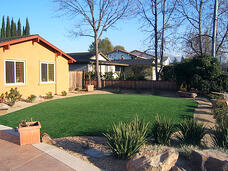 Lawn fertilizer is used to supply grass with nutrients it needs to thrive and grow. Most of the components found in fertilizer already exists in the soil in abundant amounts. Although the amounts may vary, what the grass needs is already in place and being absorbed as it is needed. In the minds of many, more is better and the application of fertilizer to an already green lawn is a necessity if you want your lawn to remain green and growing for any length of time. This type of thinking has its drawbacks, however.
Lawn fertilizer is used to supply grass with nutrients it needs to thrive and grow. Most of the components found in fertilizer already exists in the soil in abundant amounts. Although the amounts may vary, what the grass needs is already in place and being absorbed as it is needed. In the minds of many, more is better and the application of fertilizer to an already green lawn is a necessity if you want your lawn to remain green and growing for any length of time. This type of thinking has its drawbacks, however.
What Happens When too Much Fertilizer Is Used?
When the ground is already saturated with nutrients, there is no need for fertilizer. When it is applied, it does not get taken in by the plants because they already have what they need. Instead, it is washed away by rain or water from a sprinkler system and carried into lakes, streams, ponds and underground aquifers. Too much lawn fertilizer can cause the ecosystem to go out of balance. Fertilizer can lead to an overgrowth of algae in lakes and ponds. Algae monopolizes the oxygen in the water causing fish and other wildlife to die off.
Phosphorus and nitrogen, the two main elements in fertilizer can have a dramatic impact on the ecosystem. Phosphorus remains in the soil and can become a strong pollutant if allowed to build up over time. Nitrogen, on the other hand, is flushed through the soil and drains directly into ground water supplies. This is what causes the overabundance of algae and other plant life.
Lawn fertilizer can affect both surface water as well as underground water supplies. In areas, where the ground is extremely hard, the water will continue to move along its surface. Because it isn't absorbed into the ground, the phosphorus cannot bind with the soil and is carried into lakes and streams wreaking havoc as it goes.
Ways You Can Avoid Damaging the Environment with Fertilizer
There are several things homeowners can do to prevent the environmental issues associated with lawn care. Protecting the environment is important and can be accomplished along with having a beautiful, lush, green lawn.
-
Use organic forms of fertilizer – Organic fertilizers use less nitrogen and phosphorus and are geared toward maintaining a healthy, balanced ecosystem. They may cost a little more than inorganic fertilizers but, in the long run, they are well worth the extra expense. They are also less likely to cause side effects in pets that are allowed to play on the lawn.
-
Use fertilizer sparingly – More is not always better. If you feel the need to fertilize your lawn, do it sparingly. It truly does not need much at all to thrive.
-
Install artificial turf in place of natural grass. Artificial turf does not need lawn fertilizer, nor does it require constant watering to keep it beautiful and ever green. Artificial grass will last several years and does not need to be mowed, trimmed, watered or raked on a regular basis. It provides all of the benefits of a beautiful lawn with none of the maintenance and upkeep.
It isn't hard to maintain a beautiful lawn. Nature can do quite well on its own without the addition of potentially hazardous amounts of fertilizer and weed killers. If you want a pristine lawn and still want to remain environmentally conscious, the option of artificial turf can provide a win win situation. If you choose to keep your natural grass, let nature do its job and only fertilize as absolutely necessary. This keeps your lawn looking nice and helps to maintain a balanced, healthy ecosystem.










